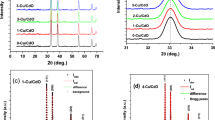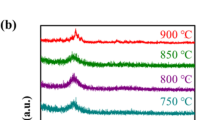Abstract
In this paper e-beam evaporation technique is used for nc-Si film deposition rather than conventional plasma enhanced chemical vapor deposition (PECVD). In present work, the nc-Si films of different thicknesses (100, 150 and 200 nm) was deposited on Corning glass 1737 substrate using e-beam evaporation method with controlled beam current and deposition rate at moderately low temperature. The deposited nc-Si films were further characterized using FESEM, EDS, XRD, Raman Spectroscopy and AFM. The results of XRD and RAMAN confirm the nanocrystalline nature of the deposited film and the FESEM and AFM results demonstrate that the grain size increases with the increase in film thickness. To validate the feasibility of deposited film for TFT application, conductivity measurement is carried using 4-probe technique. The results indicate that e-beam evaporation is the cost effective alternative of PECVD and controlled grain size and density of nc-Si film can be easily achieved.










Similar content being viewed by others
References
B. Rech, T. Roschek, J. Müller, S. Wieder, H. Wagner, Amorphous and microcrystalline silicon solar cells prepared at high deposition rates using RF (13.56 MHz) plasma excitation frequencies. Sol. Energy Mater. Sol. Cells 66, 267–273 (2001)
A. Sobhani, N.M. Salavati, A new simple route for the preparation of nanosized copper selenides under different conditions. Ceram. Int. 40, 8173–8182 (2014)
A. Sobhani, N.M. Salavati, Hydrothermal synthesis, characterization, and magnetic properties of cubic MnSe 2/Se nanocomposites material. J. Alloys Compd. 617, 93–101 (2014)
A. Sobhani, N.M. Salavati, A polyethylene glycol-assisted hydrothermal synthesis of FeSe2 nanoparticles and FeSe2/FeO(OH) nanocomposites. J. Alloys Compd. 625, 26–33 (2015)
A. Sobhani, N.M. Salavati, CdSe nanoparticles: facile hydrothermal synthesis, characterization and optical properties. J. Mater. Sci.: Mater. Electron. 26, 6831–6836 (2015)
A. Sobhani, N.M. Salavati, Optimized synthesis of ZnSe nanocrystals by hydrothermal method. J. Mater. Sci.: Mater. Electron. 27, 293–303 (2016)
A. Sobhani, N.M. Salavati, M. Sobhani, Synthesis, characterization and optical properties of mercury sulfides and zinc sulfides using single-source precursor. Mater. Sci. Semicond. Process. 16(2), 410–417 (2013)
M. Birkholz, B. Selle, E. Conrad, K. Lips, W. Fuhs, Evolution of structure in thin microcrystalline silicon films grown by electron-cyclotron resonance chemical vapor deposition. J. Appl. Phys. 88, 4376–4379 (2000)
M.K. Van Veen, C.H.M. Van Der Werf, R.E.I. Schropp, Tandem solar cells deposited using hot-wire chemical vapor deposition. J. Non-Cryst. Solids 338, 655–658 (2004)
Y. Mai, S. Klein, R. Carius, H. Stiebig, L. Houben, X. Geng, F. Finger, Improvement of open circuit voltage in microcrystalline silicon solar cells using hot wire buffer layers. J. Non-Cryst. Solids 352, 1859–1862 (2006)
H. Li, R.H. Franken, R.L. Stolk, C.H.M. Van der Werf, J.K. Rath, R.E.I. Schropp, Controlling the quality of nanocrystalline silicon made by hot-wire chemical vapor deposition by using a reverse H2 profiling technique. J. Non-Cryst. Solids 354, 2087–2091 (2008)
V. Koval, O. Bogdan, Y. Yakymenko, Study of nanocrystalline silicon thin films for application in solar cells, NANOCON2012, Brno, Czech Republic, EU, 2012, 23–25 October
C.H. Cheng, P.S. Wang, C.I. Wu, G.R. Lin, Nano-crystalline silicon-based bottom gate thin-film transistor grown by LTPECVD with hydrogen-free He diluted SiH4. J. Disp. Technol. 9, 536–544 (2013)
L. Teng, W.A. Anderson, Thin-film transistors on plastic and glass substrates using silicon deposited by microwave plasma ECR-CVD. IEEE Electron Device Lett. 24, 399–401 (2003)
C.H. Lee, S. Andrei, N. Arokia, R. John, Directly deposited nanocrystalline silicon thin-film transistors with ultra high mobilities. Appl. Phys. Lett. 89, 2101 (2006)
T. Kamei, M. Kondo, A. Matsuda, A significant reduction of impurity contents in hydrogenated microcrystalline silicon films for increased grain size and reduced defect density. Jpn. J. Appl. Phys. 37, L265–L268 (1998)
W. Kern, The evolution of silicon wafer cleaning technology. J. Electrochem. Soc. 137, 1887–1892 (1990)
J.I. Langford, A.J. Wilson, Scherrer after sixty years: a survey and some new results in the determination of crystallite size. J. Appl. Crystallogr. 11, 102–113 (1978)
T. Okada, T. Iwaki, H. Karasawa, K. Yamamoto, Probing the crystallinity of evaporated silicon films by raman scattering. Jpn. J. Appl. Phys. 24, 161–165 (1985)
J. H. Park, S. M. Han, Y. H. Choi, S. J. Kim, M. K. Han, New in-situ process of top gate nanocrystalline silicon thin film transistors fabricated at 180° C for the suppression of leakage current, in IEEE International Electron Devices Meeting, Washington, 2007, Dec 10–12, pp. 595–598
R.B. Min, S. Wagner, Nanocrystalline silicon thin-film transistors with 50-nm-thick deposited channel layer, 10 cm2V−1s−1 electron mobility and 108 on/off current ratio. Appl. Phys. A. 74, 541–543 (2002)
Acknowledgements
We would like to thank to Indian Nanoelectronics Users Program (INUP) for providing me the opportunity to doing this work in Centre of Excellence in Nanoelectronics (CEN) lab, IIT Bombay and also like to acknowledge CSIR-HRDG for providing Senior Research Fellowship (SRF) as financial support.
Author information
Authors and Affiliations
Corresponding author
Rights and permissions
About this article
Cite this article
Sharma, P., Tripathi, N. & Gupta, N. Nanocrystalline silicon thin film prepared by e-beam evaporation for display application. J Mater Sci: Mater Electron 28, 3891–3896 (2017). https://doi.org/10.1007/s10854-016-6002-3
Received:
Accepted:
Published:
Issue Date:
DOI: https://doi.org/10.1007/s10854-016-6002-3




